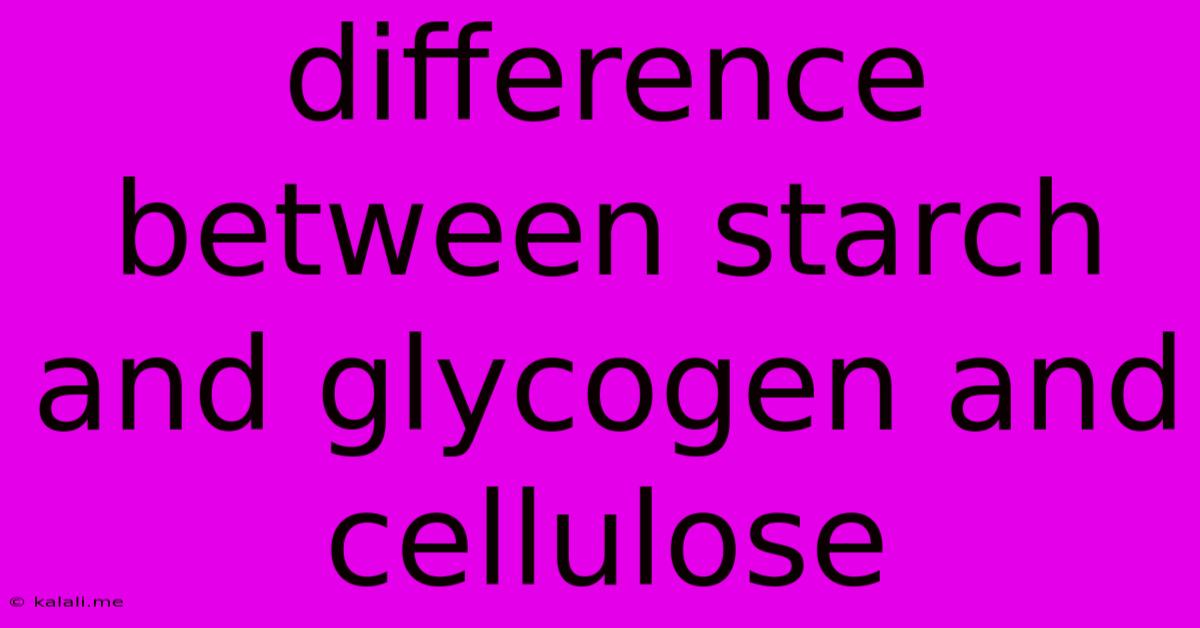Difference Between Starch And Glycogen And Cellulose
Kalali
Jun 13, 2025 · 3 min read

Table of Contents
The Amazing Trio: Starch, Glycogen, and Cellulose – Understanding Their Key Differences
Carbohydrates are essential biomolecules, providing energy and structural support to living organisms. Among the most important carbohydrates are starch, glycogen, and cellulose – all polymers of glucose, yet vastly different in their structure, function, and digestibility. This article delves into the key distinctions between these three crucial polysaccharides. Understanding their differences is crucial for appreciating their diverse roles in biology and various industrial applications.
What are Polysaccharides? Before diving into the specifics, let's clarify that starch, glycogen, and cellulose are all polysaccharides. Polysaccharides are long chains of monosaccharides (simple sugars), linked together through glycosidic bonds. The type of bond, the branching pattern, and the overall structure determine the unique properties of each polysaccharide.
Starch: The Plant's Energy Reserve
Starch is the primary energy storage polysaccharide in plants. It's found abundantly in seeds, roots, and tubers, providing energy for plant growth and development. Starch exists in two main forms:
- Amylose: A linear chain of glucose molecules linked by α-1,4-glycosidic bonds. This linear structure makes amylose relatively insoluble in water.
- Amylopectin: A branched chain of glucose molecules, with α-1,4-glycosidic bonds forming the linear chains and α-1,6-glycosidic bonds creating branches. The branching allows for more compact storage and faster glucose release.
The ratio of amylose to amylopectin varies depending on the plant source. This variation affects the properties of the starch, such as its digestibility and viscosity. Humans and many animals possess enzymes (amylases) that can break down starch into glucose, providing energy. Starch is a key component of our diet, found in various foods like potatoes, rice, wheat, and corn.
Glycogen: The Animal's Energy Depot
Glycogen is the main energy storage polysaccharide in animals and fungi. Similar to amylopectin, it's a highly branched polymer of glucose linked by α-1,4-glycosidic bonds with α-1,6-glycosidic bonds at the branch points. However, glycogen is even more highly branched than amylopectin, allowing for rapid glucose mobilization when energy is needed. It's stored primarily in the liver and muscles, readily available to meet the body's energy demands. Glycogen's highly branched structure allows for quick access to glucose units, ensuring a rapid energy supply during periods of high activity or fasting.
Cellulose: The Structural Backbone of Plants
Unlike starch and glycogen, cellulose serves a structural role. It's the most abundant organic polymer on Earth, forming the primary component of plant cell walls. Cellulose is a linear polymer of glucose molecules linked by β-1,4-glycosidic bonds. This seemingly small difference in the glycosidic bond (β instead of α) profoundly impacts its properties. The β-1,4 linkage creates a straight chain, allowing for the formation of strong hydrogen bonds between adjacent cellulose molecules, resulting in rigid, insoluble fibers. Humans lack the necessary enzymes (cellulases) to break down cellulose, making it indigestible. However, cellulose plays a crucial role in our diet as dietary fiber, promoting gut health and regularity. Herbivores, on the other hand, possess specialized microorganisms in their digestive systems that can break down cellulose, allowing them to utilize it as an energy source.
Summary Table: Starch, Glycogen, and Cellulose
| Feature | Starch | Glycogen | Cellulose |
|---|---|---|---|
| Monomer | Glucose | Glucose | Glucose |
| Glycosidic Bond | α-1,4 (and α-1,6 in amylopectin) | α-1,4 (and α-1,6) | β-1,4 |
| Structure | Linear (amylose), Branched (amylopectin) | Highly Branched | Linear |
| Function | Energy storage (plants) | Energy storage (animals) | Structural support (plants) |
| Digestibility | Digestible by humans | Digestible by humans | Indigestible by humans |
Understanding the differences between starch, glycogen, and cellulose highlights the remarkable diversity of polysaccharides and their crucial roles in living organisms. From energy storage to structural support, these molecules are fundamental to the functioning of the biological world.
Latest Posts
Latest Posts
-
Which Cycle Is Not A Major Biogeochemical Cycle
Jun 14, 2025
-
Good Conductor Of Heat And Electricity Metal Or Non Metal
Jun 14, 2025
-
Which Of The Following Statements About Interjections Is False
Jun 14, 2025
-
What Is The Lcm Of 2 And 11
Jun 14, 2025
-
How Are Protists And Bacteria Different
Jun 14, 2025
Related Post
Thank you for visiting our website which covers about Difference Between Starch And Glycogen And Cellulose . We hope the information provided has been useful to you. Feel free to contact us if you have any questions or need further assistance. See you next time and don't miss to bookmark.